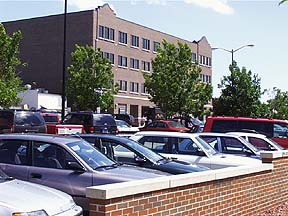

 Parking has been shown to be one of the most enigmatic factors in downtown revitalization. Should there be more parking? Should there be parking meters to control the length of time spaces are used by customers? How important is parking to commercial vitality? These are questions that are asked over and over.
Parking has been shown to be one of the most enigmatic factors in downtown revitalization. Should there be more parking? Should there be parking meters to control the length of time spaces are used by customers? How important is parking to commercial vitality? These are questions that are asked over and over.Parking is a major design element for any transportation system that involves automobiles. Parking can occupy the largest portion of a commercial site plan. Suburban projects usually include land to accommodate this need; center city areas often do not have sufficient land available, and providing parking becomes a problem in revitalization efforts. Although some planners feel that parking has received too much attention as a tool of community revitalization-the primary strategy to create a successful commercial district is to have goods and services that are desired-it must be addressed nonetheless.
Some general guidelines for parking facilities are: (1) make the flow of traffic to parking areas readily apparent without excessive signage; (2) locate pedestrian walkways to and from parking such that there is minimal conflict with automobiles; and (3) allow adequate parking spaces near building entrances for handicapped persons.
In a parking lot, access lanes should be separated from parking lanes. There should be convenient drop-off locations for passengers. Access for trucks and service vehicles to building entrances and Dumpster locations should be separated from parking traffic. Many of these standards are incorporated in the zoning ordinance, but all represent good design principles based on user convenience.
When large paved areas are necessary to provide sufficient parking spaces, these areas should be visually broken into smaller sections with landscaping, low walls, or other features; however, do not create areas that cannot be easily monitored for safety. Parking aisles should be no longer than 30 contiguous spaces. For better aesthetics, the edges of the parking lot should be screened so only tops of vehicles can be seen, not their full height.
Many zoning ordinances require parking areas to be sized for the greatest possible capacity: in retail areas this is typically considered the day after Thanksgiving and the Saturday before Christmas, the only days of the year when the lot may be filled. Many communities now are reconsidering such high requirements. Smaller parking areas reduce the amount of overall paved land, which minimizes loss of productive land area, heat buildup from asphalt, drainage problems, and environmental considerations. Conventional paved parking lots are impervious to rain water, causing rapid runoff, erosion, and flood damage during severe storms. New paving materials, such as permeable asphalt and concrete, allow drainage through the pavement and reduce potential site drainage and flooding problems.
The costs of parking are a major consideration. Surface parking lots are much less expensive to create than structures or underground parking. The cost of a surface lot averages $2,000 to $3,000 per space, while above-ground parking structures average $20,000 to $25,000 per space and underground parking $30,000 to $40,000 per space. In spite of the high cost, above- or underground parking structures may be justified in dense urban areas, where land is expensive; elevator parking, although expensive, can also multiply the number of spaces on a given sized site, since cars are stored without the need for driving lanes. The cost may be partially offset by planning for shared parking, where automobiles at different times of the day or week can utilize the same spaces.
In some American cities, so much of the center has been cleared to make way for parking that there is more parking than there is city. Some cities... have gone so far as to reach a tipping point. If they clear away any more of what's left, there would not be much reason to go there and park.Is this true? Is parking overrated? And has it received too much attention in the past as a tool of downtown revitalization? One way to consider this question is to think of a city where you like to visit--do you make the decision to go there because of convenient parking? This is not likely. More to the point, you would choose to go there because of the goods and services offered. This is the key to downtown revitalization, not convenient parking.A first step to liberation would be a reduction in the additional amounts of parking required. Communities... still indulge the parker to an excessive degree, smaller cities in particular...
What would happen if additional parking was not provided? In New York, the South Street Seaport brought approximately 300,000 square feet of retailing to its site and it is jammed with customers. Not one additional parking space has been provided. Some people take the subway; some, the bus. The bulk, mostly office workers, walk to the place.
So far, the only hopeful action has been not adding more parking. Before long, we may actually start cutting it. It might make economic sense. In their zeal to woo the car, developers and municipalities grabbed off some of the best-located parcels of downtown... There is a lot of valuable land under that concrete. 2
| City-owned vacant sites | Automobiles and Pedestrians | Need More Parking? |
|---|
